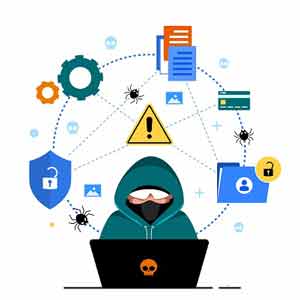What is a phishing attack in cyber security?
Phishing is a type of cyber attack that uses fraudulent emails or websites to trick users into revealing sensitive information, such as passwords or credit card numbers. This information is then used by the attacker to gain access to the victim’s accounts or systems. Phishing attacks are on the rise, due in part to the increasing sophistication of attackers and the growing number of ways they can target victims. However, there are steps you can take to protect yourself from these attacks. In this blog post, we will discuss what phishing is, how it works, and how you can defend yourself against these threats.

What is phishing? How does one identify phishing attacks?
Phishing is a type of cyber attack that uses fraudulent emails or websites to trick victims into revealing sensitive information, such as login credentials or credit card numbers. Phishing attacks can be difficult to identify, as attackers often spoof legitimate websites or use convincing email messages to lure victims. However, there are some telltale signs that an email or website may be part of a phishing attack, such as misspellings and grammatical errors, unusual sender addresses, and unexpected attachments. If you suspect you may be the target of a phishing attack, do not respond to the message or click any links. Instead, contact your IT department or security team for help.
What is the purpose of a phishing attack?
A phishing attack is a type of cyberattack in which an attacker masquerades as a trustworthy entity in order to trick victims into revealing sensitive information, such as login credentials or financial information. Phishing attacks are typically carried out via email or text message, and often target large organizations in an attempt to steal customer data or gain access to corporate networks.
What are different types of Phishing attacks?
Phishing attacks come in many different forms, but they all have one goal: to trick you into giving up sensitive information. The most common types of phishing attacks are:
1. Email Phishing: This type of phishing attack comes in the form of an email that looks like it’s from a legitimate source, like your bank or a company you do business with. The email will usually contain a link that takes you to a fake website that looks real. Once you enter your login information, the attacker now has access to your account.
2. SMS Phishing (Smishing): This type of phishing attack uses text messages instead of emails to try and trick you. The message may look like it’s from your bank or another legitimate source and will often contain a link. If you click on the link, you’ll be taken to a fake website where you’re asked to enter sensitive information.
3. Phone Phishing (Vishing): In this type of phishing attack, someone will call you pretending to be from a legitimate company or institution. They may say there’s a problem with your account or that they need verify some personal information. If you give them what they want, they now have access to your accounts or can commit fraud in your name.
4. Malicious Websites: These websites are designed to look like legitimate websites, but they’re actually fake websites set up
How does a phishing email attack a target?
Phishing emails are one of the most common cyber security threats. They are typically sent by attackers in an attempt to gain access to a target’s sensitive information, such as login credentials or financial information.
Phishing emails often masquerade as legitimate communications from trusted sources, such as businesses or organizations that the target is familiar with. The email may contain a link that directs the target to a malicious website that resembles a legitimate website. Once on the website, the attacker can collect the target’s sensitive information through various means, such as online forms or fake login pages.
In some cases, phishing emails may also contain attachments that, if opened, can install malware on the target’s computer. This malware can allow attackers to remotely access and control the victim’s machine, giving them access to all of their files and data.
Attackers may also use phishing emails to spread malware to other victims. This can be done by including links or attachments that, when opened by unsuspecting recipients, infect their computers with malware. The attacker can then use this malware to gain access to all of the victim’s files and data.
Why should I be aware of a phishing attack?
When you receive an email, text, or pop-up message that looks like it’s from a legitimate source but is actually from a hacker, that’s called phishing. The hacker uses the phishing attack to try to steal your sensitive information like passwords, account numbers, or Social Security numbers.
Phishing attacks are becoming more and more common as hackers get better at disguising their fraudulent messages. And since phishing messages can look so convincing, it’s important to know how to spot them.
There are a few different ways that you can tell if a message is part of a phishing attack:
The sender’s email address doesn’t match the organization that they claim to be from. For example, the email might say it’s from your bank, but the actual sender address is something like “no-reply@randomwebsite.com.”
The message contains grammar or spelling errors. This is often a telltale sign that the message didn’t come from a legitimate organization.
The message asks you for personal information or login credentials. Legitimate organizations will never ask you for this type of information via email or pop-up message.
If you receive a message that fits any of these criteria, do not respond to it and do not click on any links contained in the message. Delete the message immediately to protect yourself from falling victim to a phishing
Is phishing an active or passive attack?
Phishing is an active attack where a cybercriminal pretends to be a trustworthy entity in order to obtain sensitive information from victims. This can be done through various means, such as emails, instant messages, and phone calls. In order to carry out a phishing attack, the attacker will typically create a fake website or email that looks identical to the legitimate one. They will then send this out to their potential victims and try to get them to input their personal information or click on malicious links. Phishing attacks can be very difficult to detect, so it is important for users to be aware of the signs that they may be under attack.
How to protect your organization from phishing attacks?
Phishing attacks are a type of cyber attack where an attacker attempts to trick a victim into clicking on a malicious link or opening a malicious attachment. These attacks can result in the victim’s sensitive information being stolen or their machine being infected with malware.
Organizations can protect themselves from phishing attacks by implementing security awareness training for their employees. This training should include information on how to identify phishing emails and what to do if they receive one. Additionally, organizations should consider implementing email filtering solutions that can block phishing emails from reaching employees’ inboxes.
What’s the difference between phishing and vishing?
When it comes to phishing vs vishing, there are a few key differences. Phishing is typically done through email, while vishing is done over the phone. With phishing, attackers will often spoof a legitimate website or send an email that looks like it’s from a reputable company in order to get victims to enter their personal information. With vishing, attackers will pose as a customer service representative or someone from a trusted organization and try to trick victims into giving them sensitive information over the phone.
Both phishing and vishing can be incredibly effective at stealing people’s personal information. That’s why it’s important to be aware of the dangers of these attacks and know how to protect yourself. If you receive an unsolicited email or phone call from someone asking for personal information, don’t respond. And if you’re not sure whether an email or website is legitimate, don’t click on any links or enter any information—contact the company directly to verify first.


